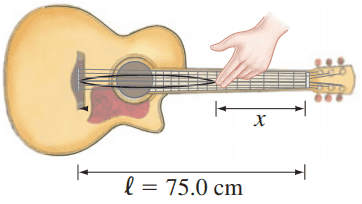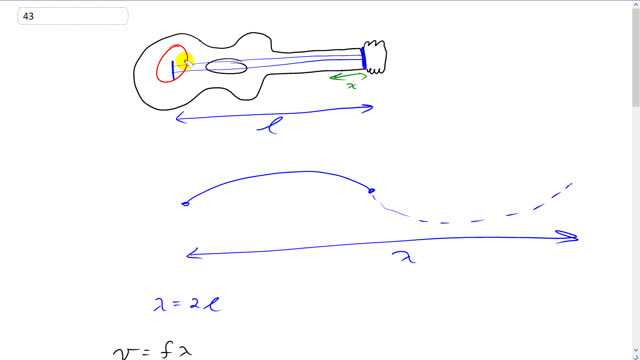
When a player’s finger presses a guitar string down onto a fret, the length of the vibrating portion of the string is shortened, thereby increasing the string’s fundamental frequency (see Fig. 12–36). The string’s tension and mass per unit length remain unchanged. If the unfingered length of the string is l = 75.0 cm, determine the positions of the first six frets, if each fret raises the pitch of the fundamental by one musical note compared to the neighboring fret. On the equally tempered chromatic scale, the ratio of frequencies of neighboring notes is .


In order to watch this solution you need to have a subscription.
This is Giancoli Answers with Mr. Dychko. So, the guitar string stretches from the bridge down here to the tuning nut up there. And that's the resonating length of the string, from there to there. And there's going to be a fret place here a distance x from the tuning nut such that you get the next half step higher frequency. The, you know, the... You know, on the chromatic scale each note is considered a half step apart. So, the wavelength on the string is going to be 2 times the string length because since the string has a node at each end when it's resonating in the fundamental mode, that's half of a wavelength. And so, continuing as a dotted line here shows a full wavelength is going to be twice the length here. And we know this formula for a wave, its speed is the frequency times its wavelength. And we can solve this for wavelength by dividing both sides by f. And we just mentioned that wavelength is 2 l. So, we put that here. And we see the length of the string is v over 2 f and we're making this formula because we need to know what lengths should the vibrating portion of the string have for these other frequencies. So, we need a formula connecting, relating length and frequency. So, there we have it. And in this first configuration here with being unfingered, the length is 75 centimeters. Now, for the first length that we're going to consider where you have the first fret, the length is going to be v, the same wave speed because it's the same tension and it's the same string. So, same mass per unit length. Divided by 2 times this new frequency. And this first fretted fingered frequency is going to be 2 to the power of 1/12 times the frequency before it. This is just a number we're given as the ratio between frequencies in the... What do they call it? Equally tempered chromatic scale, yeah. So, that means l1 is v over 2 times this, 2 to the power of 1/12 times f. And I can rewrite it this way. And we see that we have v over 2 f, and that is the original length unfingered. So, the first fretted length is the unfingered length divided by 2 to the power of 1/12. And the fret position is going to be the full length of the string minus the l1 needed for the first fretted position. And now we can generalize this formula which means make it applicable to other configurations, not just the first fretted note, but any note, the nth fretted note. And ln is going to be l divided by 2 to the power of 1/12 to the power of n. Because you can see a pattern emerging here because if we had l2, it would be l divided by, or it'd be l1 divided by 2 to the power of 12 but l1 is l divided by 2 to the 1/12 as we see here. And that's all getting divided by 2 to the power of 1/12. Then we can see that, you know, this pattern goes on and on and on. If we had l3, it'd be the same type of deal, where you have this many divisions by 2 to the power of 1/12 as the index there. So, l3 is going to be l divided by 2 to the 1/12, 3 times. And so that's what this exponent does is it divides by this thing that many times. And so ln is l divided by 2 to the power of 1/12 to the power n. So that makes xn equal to l minus l divided by 2 to the power of 1/12 to the power of n. And you can factor out the l and I did another slightly fancy thing there, where I multiply this by this exponent here. And so that becomes 2 to the power of n over 12. And dividing by, a power is the same as multiplying, by the same thing with the negative exponent which is another way of saying, you can multiply by something's reciprocal rather than dividing by it. So, 1 over x to the n is the same as going x to the power of negative n. This negative sign in the exponent makes reciprocal. So, and we get... And so this turns into this. It's good enough to say that? Hopefully. So, there we go. We have a formula. Let's plug and chug. We have x1, the first fret has to be 75 centimeters l times 1 minus 2 to the power of negative 1/12. And that's going to be 4.21 centimeters and so on and so on for the second, third, fourth, fifth and sixth fret position. It's always 75 centimeters times 1 minus 2 to the power of whatever this index is here, over 12 negative. And that's 8.18 centimeters x3, you have a 3 there, 11.9 centimeters. x4,15.5 centimeters, x5, 18.8 centimeters and x6 22.0 centimeters. And now you can have a sort of a sense of why when you look at a guitar, the frets are not evenly spaced because this is the formula that tells their spacing and it's not linear.